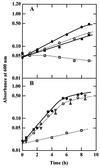Expression of outer membrane proteins in Escherichia coli growing at acid pH
- PMID: 10698756
- PMCID: PMC91927
- DOI: 10.1128/AEM.66.3.943-947.2000
Expression of outer membrane proteins in Escherichia coli growing at acid pH
Abstract
It is generally accepted for Escherichia coli that (i) the level of OmpC increases with increased osmolarity when cells are growing in neutral and alkaline media, whereas the level of OmpF decreases at high osmolarity, and that (ii) the two-component system composed of OmpR (regulator) and EnvZ (sensor) regulates porin expression. In this study, we found that OmpC was expressed at low osmolarity in medium of pH below 6 and that the expression was repressed when medium osmolarity was increased. In contrast, the expression of ompF at acidic pH was essentially the same as that at alkaline pH. Neither OmpC nor OmpF was detectable in an ompR mutant at both acid and alkaline pH values. However, OmpC and OmpF were well expressed at acid pH in a mutant envZ strain, and their expression was regulated by medium osmolarity. Thus, it appears that E. coli has a different mechanism for porin expression at acid pH. A mutant deficient in ompR grew slower than its parent strain in low-osmolarity medium at acid pH (below 5.5). The same growth diminution was observed when ompC and ompF were deleted, suggesting that both OmpF and OmpC are required for optimal growth under hypoosmosis at acid pH.
Figures






Similar articles
-
A phosphorylation site mutant of OmpR reveals different binding conformations at ompF and ompC.J Mol Biol. 2002 Jan 25;315(4):497-511. doi: 10.1006/jmbi.2001.5222. J Mol Biol. 2002. PMID: 11812125
-
Roles of the EnvZ/OmpR Two-Component System and Porins in Iron Acquisition in Escherichia coli.mBio. 2020 Jun 23;11(3):e01192-20. doi: 10.1128/mBio.01192-20. mBio. 2020. PMID: 32576675 Free PMC article.
-
Regulation of ompC and ompF expression in Escherichia coli in the absence of envZ.J Bacteriol. 1988 Nov;170(11):5080-5. doi: 10.1128/jb.170.11.5080-5085.1988. J Bacteriol. 1988. PMID: 2846509 Free PMC article.
-
Signal transduction and gene regulation through the phosphorylation of two regulatory components: the molecular basis for the osmotic regulation of the porin genes.Mol Microbiol. 1990 Jul;4(7):1077-82. doi: 10.1111/j.1365-2958.1990.tb00681.x. Mol Microbiol. 1990. PMID: 1700256 Review.
-
From acids to osmZ: multiple factors influence synthesis of the OmpF and OmpC porins in Escherichia coli.Mol Microbiol. 1996 Jun;20(5):911-7. doi: 10.1111/j.1365-2958.1996.tb02532.x. Mol Microbiol. 1996. PMID: 8809744 Review.
Cited by
-
Genome analysis of triple phages that curtails MDR E. coli with ML based host receptor prediction and its evaluation.Sci Rep. 2023 Dec 27;13(1):23040. doi: 10.1038/s41598-023-49880-x. Sci Rep. 2023. PMID: 38155176 Free PMC article.
-
EnvZ/OmpR Two-Component Signaling: An Archetype System That Can Function Noncanonically.EcoSal Plus. 2020 Jan;9(1):10.1128/ecosalplus.ESP-0001-2019. doi: 10.1128/ecosalplus.ESP-0001-2019. EcoSal Plus. 2020. PMID: 32003321 Free PMC article. Review.
-
pH-dependent expression of periplasmic proteins and amino acid catabolism in Escherichia coli.J Bacteriol. 2002 Aug;184(15):4246-58. doi: 10.1128/JB.184.15.4246-4258.2002. J Bacteriol. 2002. PMID: 12107143 Free PMC article.
-
Contribution of the lipopolysaccharide to resistance of Shigella flexneri 2a to extreme acidity.PLoS One. 2011;6(10):e25557. doi: 10.1371/journal.pone.0025557. Epub 2011 Oct 3. PLoS One. 2011. PMID: 21984920 Free PMC article.
-
Review on the Antibacterial Mechanism of Plant-Derived Compounds against Multidrug-Resistant Bacteria (MDR).Evid Based Complement Alternat Med. 2021 Aug 16;2021:3663315. doi: 10.1155/2021/3663315. eCollection 2021. Evid Based Complement Alternat Med. 2021. PMID: 34447454 Free PMC article. Review.
References
-
- Apirakaramwong A, Fukuchi J, Kashiwagi K, Kakinuma Y, Ito E, Ishihama A, Igarashi K. Enhancement of cell death due to decrease in Mg2+ uptake by OmpC (cation-selective porin) deficiency in ribosome modulation factor-deficient mutant. Biochem Biophys Res Commun. 1998;251:482–487. - PubMed
-
- Fiedler W, Rotering H. Properties of Escherichia coli mutants lacking membrane-derived oligosaccharides. J Biol Chem. 1988;263:14684–14689. - PubMed
Publication types
MeSH terms
Substances
LinkOut - more resources
Full Text Sources
Molecular Biology Databases

